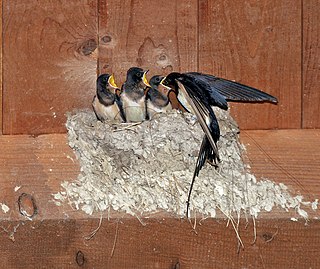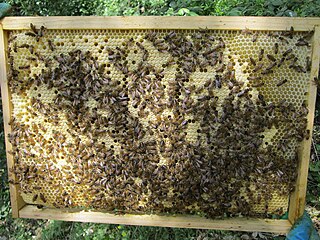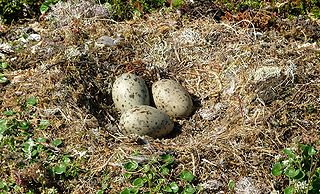Related Research Articles
Fecundity is defined in two ways; in human demography, it is the potential for reproduction of a recorded population as opposed to a sole organism, while in population biology, it is considered similar to fertility, the natural capability to produce offspring, measured by the number of gametes (eggs), seed set, or asexual propagules.

The common side-blotched lizard is a species of side-blotched lizard in the family Phrynosomatidae. The species is native to dry regions of the western United States and northern Mexico. It is notable for having a unique form of polymorphism wherein each of the three different male morphs utilizes a different strategy in acquiring mates. The three morphs compete against each other following a pattern of rock paper scissors, where one morph has advantages over another but is outcompeted by the third.

Urosaurus ornatus, commonly known as the ornate tree lizard, is a species of lizard in the family Phrynosomatidae. The species is native to the southwestern United States and northwestern Mexico. The species, which was formerly called simply the "tree lizard", has been used to study physiological changes during the fight-or-flight response as related to stress and aggressive competition. Its life history and costs of reproduction have been documented in field populations in New Mexico and Arizona. This species has been fairly well studied because of its interesting variation in throat color in males that can correlate with different reproductive strategies,

Phenotypic plasticity refers to some of the changes in an organism's behavior, morphology and physiology in response to a unique environment. Fundamental to the way in which organisms cope with environmental variation, phenotypic plasticity encompasses all types of environmentally induced changes that may or may not be permanent throughout an individual's lifespan.
Life history theory is an analytical framework designed to study the diversity of life history strategies used by different organisms throughout the world, as well as the causes and results of the variation in their life cycles. It is a theory of biological evolution that seeks to explain aspects of organisms' anatomy and behavior by reference to the way that their life histories—including their reproductive development and behaviors, post-reproductive behaviors, and lifespan —have been shaped by natural selection. A life history strategy is the "age- and stage-specific patterns" and timing of events that make up an organism's life, such as birth, weaning, maturation, death, etc. These events, notably juvenile development, age of sexual maturity, first reproduction, number of offspring and level of parental investment, senescence and death, depend on the physical and ecological environment of the organism.
Enquiry into the evolution of ageing, or aging, aims to explain why a detrimental process such as ageing would evolve, and why there is so much variability in the lifespans of organisms. The classical theories of evolution suggest that environmental factors, such as predation, accidents, disease, starvation, ensure that most organisms living in natural settings will not live until old age, and so there will be very little pressure to conserve genetic changes that increase longevity. Natural selection will instead strongly favor genes which ensure early maturation and rapid reproduction, and the selection for genetic traits which promote molecular and cellular self-maintenance will decline with age for most organisms.
Cooperative breeding is a social system characterized by alloparental care: offspring receive care not only from their parents, but also from additional group members, often called helpers. Cooperative breeding encompasses a wide variety of group structures, from a breeding pair with helpers that are offspring from a previous season, to groups with multiple breeding males and females (polygynandry) and helpers that are the adult offspring of some but not all of the breeders in the group, to groups in which helpers sometimes achieve co-breeding status by producing their own offspring as part of the group's brood. Cooperative breeding occurs across taxonomic groups including birds, mammals, fish, and insects.

Parental care is a behavioural and evolutionary strategy adopted by some animals, involving a parental investment being made to the evolutionary fitness of offspring. Patterns of parental care are widespread and highly diverse across the animal kingdom. There is great variation in different animal groups in terms of how parents care for offspring, and the amount of resources invested by parents. For example, there may be considerable variation in the amount of care invested by each sex, where females may invest more in some species, males invest more in others, or investment may be shared equally. Numerous hypotheses have been proposed to describe this variation and patterns in parental care that exist between the sexes, as well as among species.

Predator satiation is an anti-predator adaptation in which prey briefly occur at high population densities, reducing the probability of an individual organism being eaten. When predators are flooded with potential prey, they can consume only a certain amount, so by occurring at high densities prey benefit from a safety in numbers effect. This strategy has evolved in a diverse range of prey, including notably many species of plants, insects, and fish. Predator satiation can be considered a type of refuge from predators.

Eusociality, the highest level of organization of sociality, is defined by the following characteristics: cooperative brood care, overlapping generations within a colony of adults, and a division of labor into reproductive and non-reproductive groups. The division of labor creates specialized behavioral groups within an animal society which are sometimes referred to as 'castes'. Eusociality is distinguished from all other social systems because individuals of at least one caste usually lose the ability to perform at least one behavior characteristic of individuals in another caste. Eusocial colonies can be viewed as superorganisms.
Semelparity and iteroparity are two contrasting reproductive strategies available to living organisms. A species is considered semelparous if it is characterized by a single reproductive episode before death, and iteroparous if it is characterized by multiple reproductive cycles over the course of its lifetime. Iteroparity can be further divided into continuous iteroparity and seasonal iteroparity Some botanists use the parallel terms monocarpy and polycarpy.

The guppy, also known as millionfish and rainbow fish, is one of the world's most widely distributed tropical fish and one of the most popular freshwater aquarium fish species. It is a member of the family Poeciliidae and, like almost all American members of the family, is live-bearing. Guppies originate from northeast South America, but have been introduced to many environments and are now found all over the world. They are highly adaptable and thrive in many different environmental and ecological conditions. Male guppies, which are smaller than females, have ornamental caudal and dorsal fins. Wild guppies generally feed on a variety of food sources, including benthic algae and aquatic insect larvae. Guppies are used as a model organism in the fields of ecology, evolution, and behavioural studies.
Seasonal breeders are animal species that successfully mate only during certain times of the year. These times of year allow for the optimization of survival of young due to factors such as ambient temperature, food and water availability, and changes in the predation behaviors of other species. Related sexual interest and behaviors are expressed and accepted only during this period. Female seasonal breeders will have one or more estrus cycles only when she is "in season" or fertile and receptive to mating. At other times of the year, they will be anestrus, or have a dearth of their sexual cycle. Unlike reproductive cyclicity, seasonality is described in both males and females. Male seasonal breeders may exhibit changes in testosterone levels, testes weight, and fertility depending on the time of year.
Antipredatory behaviors are actions an animal performs to reduce or rid themselves of the risk of being prey. Many studies have been done on elk to see what their antipredator behaviors consist of.

Clutch size refers to the number of eggs laid in a single brood by a nesting pair of birds. The numbers laid by a particular species in a given location are usually well defined by evolutionary trade-offs with many factors involved, including resource availability and energetic constraints. Several patterns of variation have been noted and the relationship between latitude and clutch size has been a topic of interest in avian reproduction and evolution. David Lack and R.E. Moreau were among the first to investigate the effect of latitude on the number of eggs per nest. Since Lack's first paper in the mid-1940s there has been extensive research on the pattern of increasing clutch size with increasing latitude. The proximate and ultimate causes for this pattern have been a subject of intense debate involving the development of ideas on group, individual, and gene-centric views of selection.

Fecundity selection, also known as fertility selection, is the fitness advantage resulting from selection on traits that increases the number of offspring. Charles Darwin formulated the theory of fecundity selection between 1871 and 1874 to explain the widespread evolution of female-biased sexual size dimorphism (SSD), where females were larger than males.
The disposable soma theory of aging states that organisms age due to an evolutionary trade-off between growth, reproduction, and DNA repair maintenance. Formulated by Thomas Kirkwood, the disposable soma theory explains that an organism only has a limited amount of resources that it can allocate to its various cellular processes. Therefore, a greater investment in growth and reproduction would result in reduced investment in DNA repair maintenance, leading to increased cellular damage, shortened telomeres, accumulation of mutations, compromised stem cells, and ultimately, senescence. Although many models, both animal and human, have appeared to support this theory, parts of it are still controversial. Specifically, while the evolutionary trade-off between growth and aging has been well established, the relationship between reproduction and aging is still without scientific consensus, and the cellular mechanisms largely undiscovered.

Capital breeding and income breeding refer to the methods by which some organisms perform time breeding and use resources to finance breeding. In the models, capital breeders breed when they reach a threshold condition, which decreases throughout the breeding season. However, the original definition of a capital breeder has changed, with the more recent definition being organisms that use energy stores built up before reproduction to breed. This is in comparison to income breeders, who breed after certain levels, which do not change, of increase in condition are reached and who use energy gained during breeding to finance reproduction. Income breeders who are growing especially fast hold off the development of their offspring after a threshold is reached so they can produce more offspring, although this does not occur in slower growing income breeders. An organism can be both a capital and an income breeder; the parasitoid Eupelmus vuilletti, for example, is an income breeder in terms of sugars, but a capital breeder in terms of lipids. A different example of the interaction between capital and income breeding is found in Vipera aspis; although these snakes are capital breeders, they lay larger litters when food is abundant, which is a characteristic of income breeders.
Human reproductive ecology is a subfield in evolutionary biology that is concerned with human reproductive processes and responses to ecological variables. It is based in the natural and social sciences, and is based on theory and models deriving from human and animal biology, evolutionary theory, and ecology. It is associated with fields such as evolutionary anthropology and seeks to explain human reproductive variation and adaptations. The theoretical orientation of reproductive ecology applies the theory of natural selection to reproductive behaviors, and has also been referred to as the evolutionary ecology of human reproduction.
The terminal investment hypothesis is the idea in life history theory that as an organism's residual reproductive value decreases, its reproductive effort will increase. Thus, as an organism's prospects for survival decreases, it will invest more in reproduction. This hypothesis is generally supported in animals, although results contrary to it do exist.
References
- 1 2 3 4 Harshman, Lawrence G.; Zera, Anthony J. (2007). "The cost of reproduction: the devil in the details". Trends in Ecology & Evolution. 22 (2): 80–86. doi:10.1016/j.tree.2006.10.008. ISSN 0169-5347. PMID 17056152. S2CID 17970120.
- ↑ Sanz-Aguilar, Ana; Tavecchia, Giacomo; Pradel, Roger; Mínguez, Eduardo; Oro, Daniel (2008). "The cost of reproduction and experience-dependent vital rates in a small petrel". Ecology. 89 (11): 3195–3203. doi:10.1890/08-0431.1. hdl: 10261/99246 . ISSN 0012-9658. PMID 31766808. S2CID 10192054.
- 1 2 Creighton, J. Curtis; Heflin, Nicholas D.; Belk, Mark C. (2009). "Cost of reproduction, resource quality, and terminal investment in a burying beetle". The American Naturalist. 174 (5): 673–684. doi:10.1086/605963. ISSN 0003-0147. PMID 19775240. S2CID 205992473.
- ↑ Stearns, S. C. (1989). "Trade-offs in life-history evolution". Functional Ecology. 3 (3): 259–268. CiteSeerX 10.1.1.377.2661 . doi:10.2307/2389364. ISSN 0269-8463. JSTOR 2389364.
- ↑ Williams, George C. (1966). "Natural selection, the costs of reproduction, and a refinement of Lack's principle". The American Naturalist. 100 (916): 687–690. doi:10.1086/282461. ISSN 0003-0147. S2CID 84993886.
- 1 2 Zera, Anthony J.; Harshman, Lawrence G. (2001). "The physiology of life history trade-offs in animals". Annual Review of Ecology and Systematics. 32 (1): 95–126. doi:10.1146/annurev.ecolsys.32.081501.114006. ISSN 0066-4162.
- ↑ Magnhagen, Carin (1991). "Predation risk as a cost of reproduction". Trends in Ecology & Evolution. 6 (6): 183–186. doi:10.1016/0169-5347(91)90210-O. ISSN 0169-5347. PMID 21232452.